Friday July 9th
Off we went to Seattle! Sharon had a conference and Chris was to be the idle spouse, just like Boston last year.
 I (Chris) continue to be a giddy little boy when it comes to flying. I always want a window seat, and I really do spend most of the flight, even a 5 hour flight like this one, with my face pressed to the window looking down in amazement. And also looking at my GPS receiver, which I received for Christmas from my family a few years ago specifically for this purpose — seeing what I was flying over.
I (Chris) continue to be a giddy little boy when it comes to flying. I always want a window seat, and I really do spend most of the flight, even a 5 hour flight like this one, with my face pressed to the window looking down in amazement. And also looking at my GPS receiver, which I received for Christmas from my family a few years ago specifically for this purpose — seeing what I was flying over.
Here’s a crappy cell phone picture of, no lie, the Crazy Mountains.
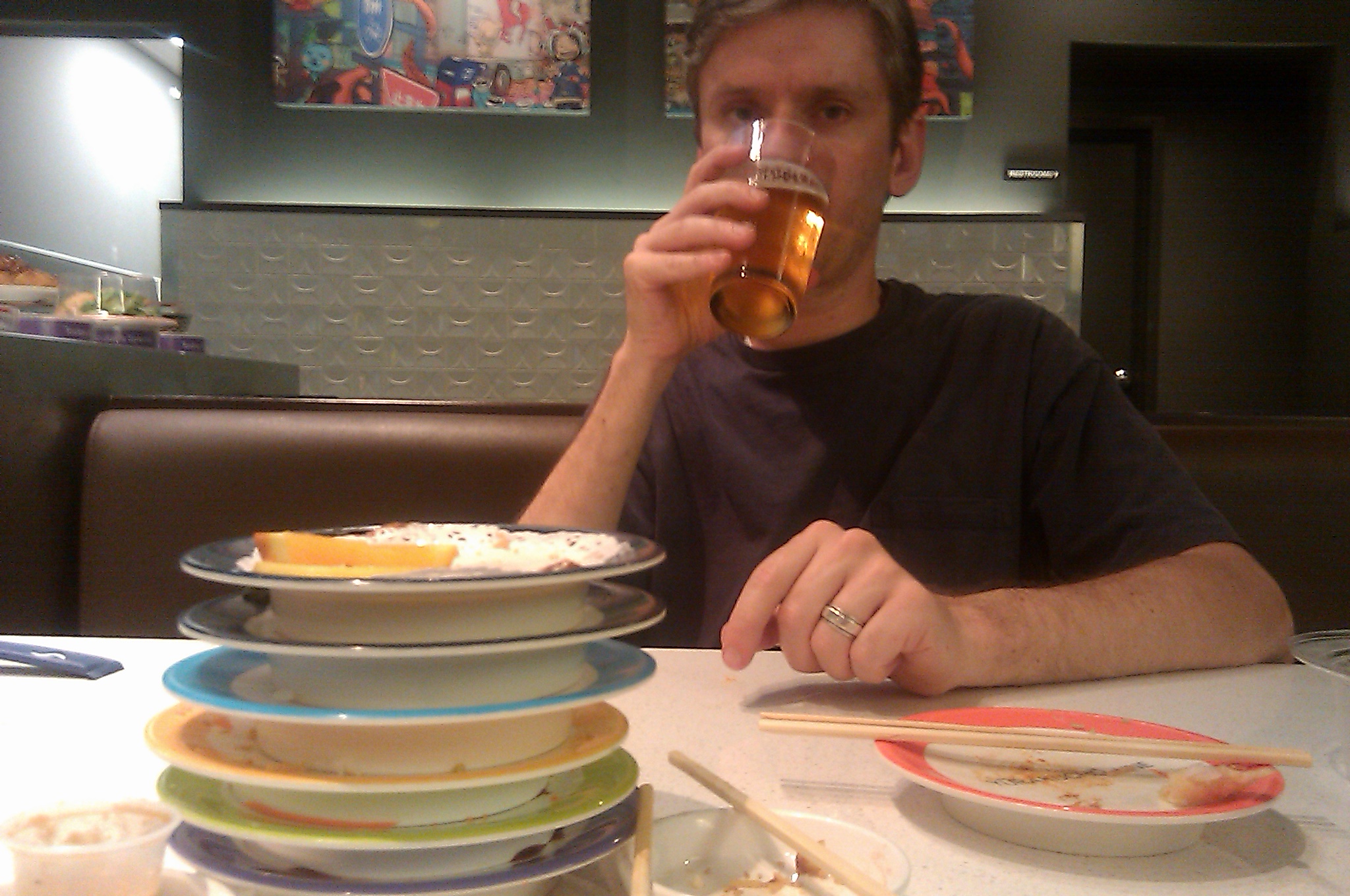 Arrived in SEA-TAC airport, took the shiny new Link train to downtown, checked into hotel, and went out for dinner. I’d identified a sushi place that appeared to be on the same block, and it turned out to be practically in the hotel. It was one of those Japanese style places with a central conveyor belt carrying pre-made plates of sushi, and you just sit next to the belt and grab what you want. It make for an oddly frenzied experience, like you’re in a competitive eating contest and must grab grab grab go go go spend spend spend!
Arrived in SEA-TAC airport, took the shiny new Link train to downtown, checked into hotel, and went out for dinner. I’d identified a sushi place that appeared to be on the same block, and it turned out to be practically in the hotel. It was one of those Japanese style places with a central conveyor belt carrying pre-made plates of sushi, and you just sit next to the belt and grab what you want. It make for an oddly frenzied experience, like you’re in a competitive eating contest and must grab grab grab go go go spend spend spend!
Saturday July 10th
We intended to go to Chinatown / Intl Center first, but were foiled by the seemingly impenetrable bus system (OneBusAway, you suck. Google Maps in transit mode, you rule).
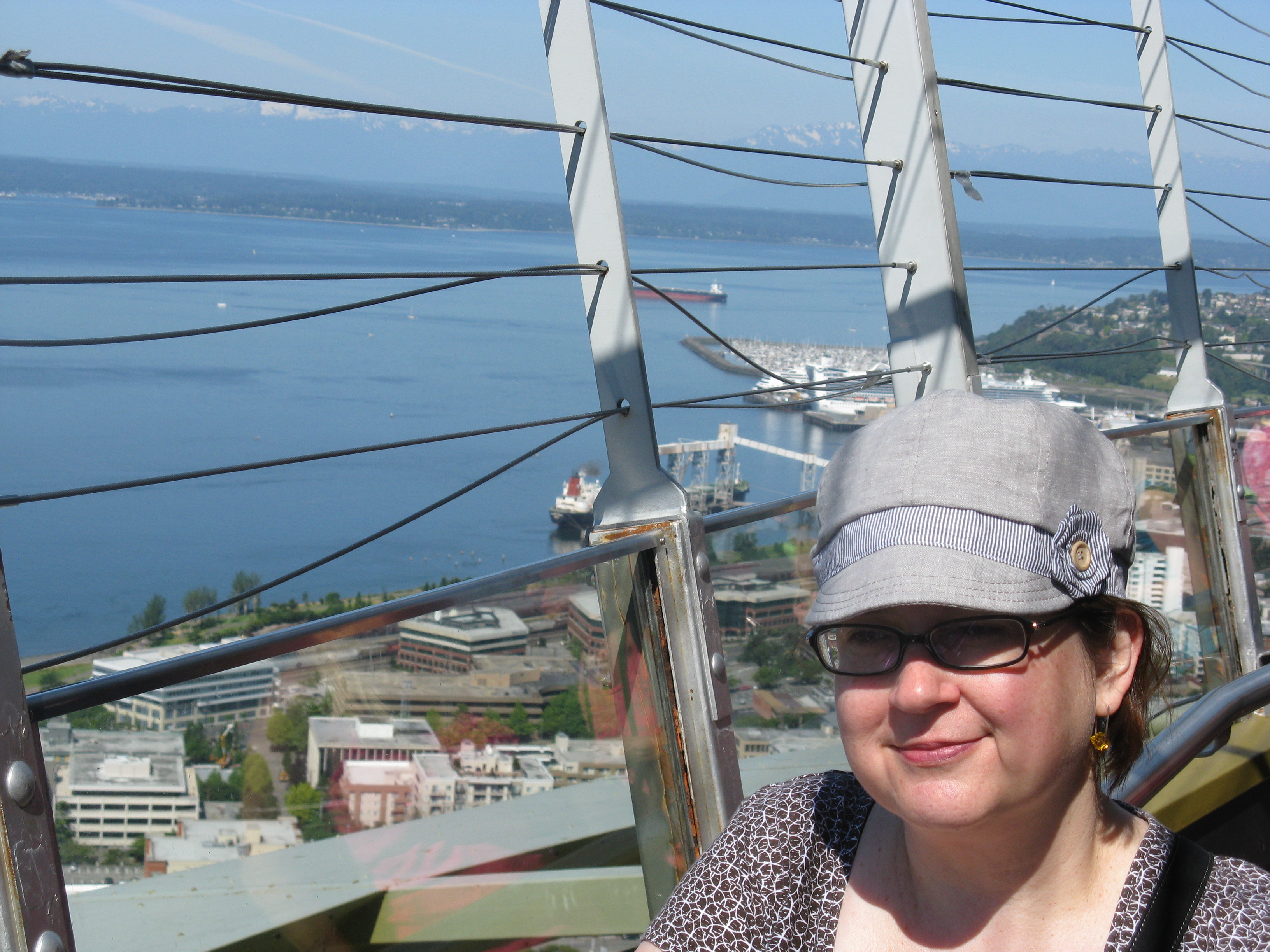 So we punted and took the monorail out to Seattle Center. The monorail, built in 1962 for the Worlds Fair (coughknoxvillecough), is perfectly functional but looking a bit dated, and really only goes from Tourist Point A (Westlake / downtown area) to Tourist Point B (Seattle Center). Seattle Center is most known for the Space Needle (more 1962 municipal construction) and the Experience Music Project, both of which we planned to studiously avoid. There was a indie craft fair (excuse me, “urban craft uprising“) that Sharon wanted to troll, and I figured I’d find some way to amuse myself. Well, we messed up on the timing thing (new timezone for us) and got to the fair hall waaaay before they opened so suddenly had time to kill. It looked like we were going up the Space Needle after all! Bought the overpriced tickets, waited in the crowded lines, went up the crowded elevator, stood on the crowded platforms, went back down. Woohoo! In doing all that, though, we did indeed kill enough time for the craft fair to open. Sharon headed into there and Chris went off on an expedition.
So we punted and took the monorail out to Seattle Center. The monorail, built in 1962 for the Worlds Fair (coughknoxvillecough), is perfectly functional but looking a bit dated, and really only goes from Tourist Point A (Westlake / downtown area) to Tourist Point B (Seattle Center). Seattle Center is most known for the Space Needle (more 1962 municipal construction) and the Experience Music Project, both of which we planned to studiously avoid. There was a indie craft fair (excuse me, “urban craft uprising“) that Sharon wanted to troll, and I figured I’d find some way to amuse myself. Well, we messed up on the timing thing (new timezone for us) and got to the fair hall waaaay before they opened so suddenly had time to kill. It looked like we were going up the Space Needle after all! Bought the overpriced tickets, waited in the crowded lines, went up the crowded elevator, stood on the crowded platforms, went back down. Woohoo! In doing all that, though, we did indeed kill enough time for the craft fair to open. Sharon headed into there and Chris went off on an expedition.
… to the Tesla dealership about a 15 minute walk away. Really, I couldn’t think of anything else to do, and thought there was a slim chance I might be able to get myself another quick drive (see April 2009). Plus they had just received the new Roadster 2.5 model in the store. Anyway, I did walk over there and see the car but didn’t get to drive anything. The receptionist there, holding down the fort while the sales staff were away at some event, kept egging me on trying to get me to buy one (“wouldn’t it be cooool if the receptionist made a sale” she giggled). Walked back to the craft fair, seeing more of what has got to be the dullest part of Seattle (I believe the neighborhood is call South Lake Union). Idled with a newspaper until it was time to meet up with Sharon again, bags in hand.
Walked down to a pizza joint for lunch, took the monorail back to downtown, and got a bus to Chinatown (I was getting better at figuring out the transit system, thanks again to my Android phone’s Google Maps in transit mode). Trekked down to an important destination — Uwajimaya Inc. This massive store has a huge collection of everything Asian, from Japanese manga in the bookstore to Chinese food ingredients in the supermarket to general Asian collectible tchotchkes.
 From there we backtracked a bit to where we’d spotted some sort of Asian street festival, which was in full swing with marching schoolgirls, information stands, a performance stage (including a robot dancing along with the Hawaiian hula demo), melon sculptures …
From there we backtracked a bit to where we’d spotted some sort of Asian street festival, which was in full swing with marching schoolgirls, information stands, a performance stage (including a robot dancing along with the Hawaiian hula demo), melon sculptures … 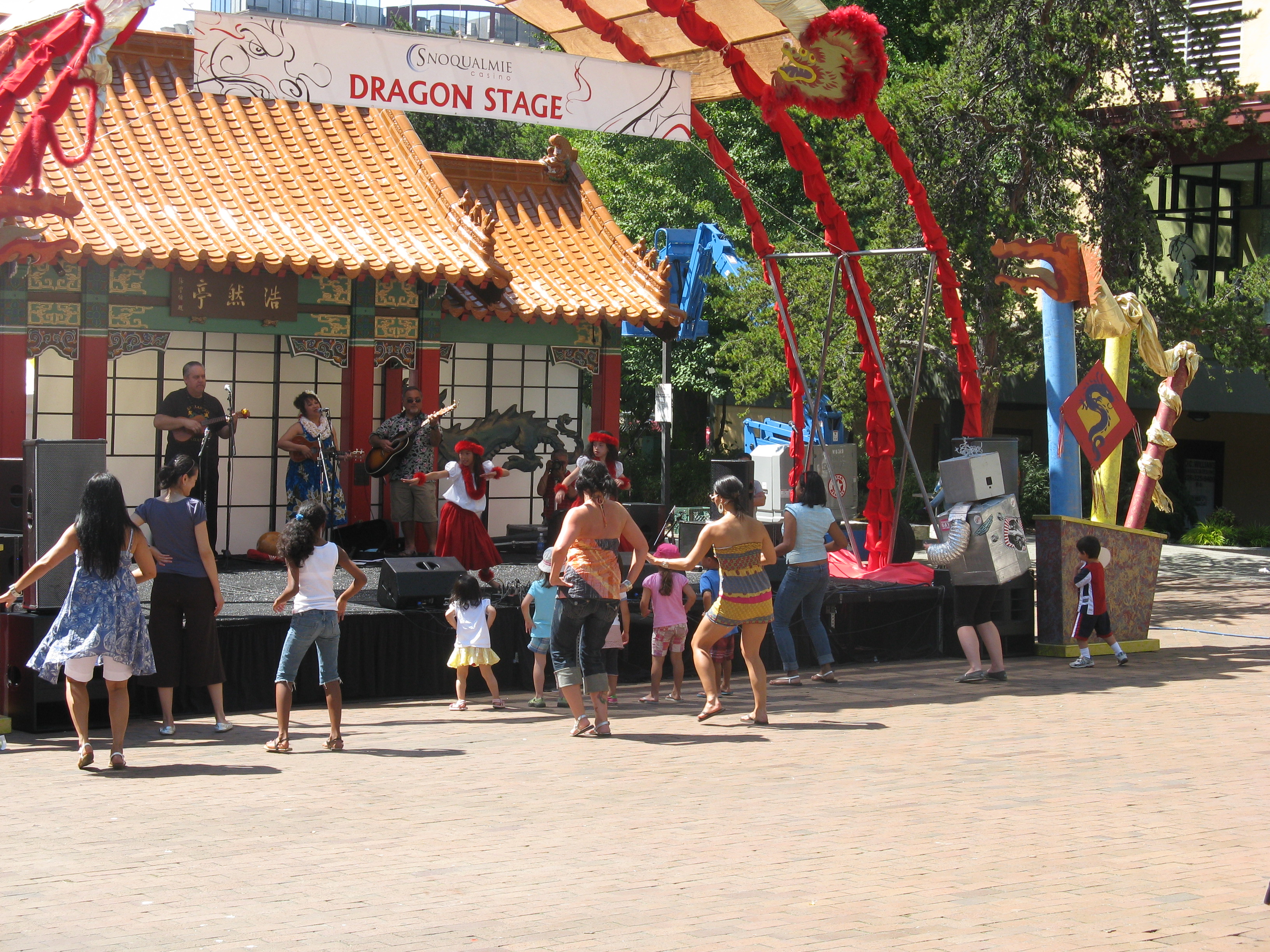 Escaped from there and on the way back to the transit station Sharon spotted a “variety store” advertising Asian wares. Inside we found a truly strange and wonderful place. Kobo at Higo is sort of an artsy collectibles store / gallery that took over an old neighborhood storefront “Higo Variety Store” after the last of the founding family members had become too frail to continue the store’s operation. Besides the Crazy Crap for Sharon to coo over, over in the back there was an installation that an “artist in residence” was assembling to give an example of what the store used to be like. It included some fascinating family history items, including transcriptions of interviews done with the elderly family members (e.g. mentions of the Japanese internment camps, a sad chapter in US history).
Escaped from there and on the way back to the transit station Sharon spotted a “variety store” advertising Asian wares. Inside we found a truly strange and wonderful place. Kobo at Higo is sort of an artsy collectibles store / gallery that took over an old neighborhood storefront “Higo Variety Store” after the last of the founding family members had become too frail to continue the store’s operation. Besides the Crazy Crap for Sharon to coo over, over in the back there was an installation that an “artist in residence” was assembling to give an example of what the store used to be like. It included some fascinating family history items, including transcriptions of interviews done with the elderly family members (e.g. mentions of the Japanese internment camps, a sad chapter in US history).
We tore ourselves away and made it back to the hotel in time for Sharon to go off to her first conference event, and later a dinner banquet with conference attendees.
Sunday July 11th
Day 1 of 2 where I (Chris) would be on my own. I walked across downtown to a bike shop where I picked up a bicycle rental — I figured bicycling would be a great way to see this bike-friendly town, and I’d brought my own helmet so I wouldn’t have to futz with getting one to fit.
But time was a wastin’. I had to get to an Irish pub (Kell’s) in Pike Place Market to catch the World Cup final, and got there in time to see the end of the first half. The place was pretty crowded, but some nice ladies let me share their table and I proceeded to get an earful of Seattle travel tips over some Irish food.
After the game, I strolled around Pike Place a bit, killing time until 3pm when I met up with two old friends from my WREK days, Allie Beerthuis and John Selbie. We got caught up on our lives and then parted ways. I had a long trip in mind for the rest of the afternoon — West Seattle and Alki Beach.
From Pike Place, it’s a long straight trip south along the back sides of somewhat dull shipyards to get to the bridge over the cargo harbor and the Industrial District to the peninsula of West Seattle. At the top of the bridge, the gates came down so they could let a sailboat through, giving me an opportunity to make a panorama photo. Mount Rainier can be seen in the distance in the center of this shot.

After crossing the bridge, you are on the east side of the peninsula, and so I biked around the northern end (along Harbor Ave and Alki Ave) to get around to the west side. Stopped at a fishing pier for the panoramic view back at the city.

And of course you can click to enlarge these photos, although the panoramas won’t enlarge by much here. If you like any of these panaroma shots in particular, email me and I’ll send you the high-res version.
 Finally reaching Alki Beach on the west side, I found … an actual beach, with sand and volleyball nets and beach bums and everything. The weather was quite sunny and hot, and it was a Sunday, so the place was jammed. Looked like the Jersey shore (well, not that Jersey shore).
Finally reaching Alki Beach on the west side, I found … an actual beach, with sand and volleyball nets and beach bums and everything. The weather was quite sunny and hot, and it was a Sunday, so the place was jammed. Looked like the Jersey shore (well, not that Jersey shore).
I then turned back east to head back towards the city, first climbing up and over the big hill that West Seattle is on. Whew, that was some exercise. Thanks to Google Maps’ transit mode (again), however, I knew that on the other side of the hill would be a bus that would take me back to downtown, with my bike mounted on the rack on the front of the bus.
Sharon and I met up for dinner, looked for something in Park Place but finding it mostly shut down on a Sunday evening, and settled for a nice place at the edge closer to Belltown.
Monday July 12th
Day 2 of 2 where I (Chris) would be on my own. Yesterday would be just a warm up, because the route I had in mind for today would take me all over the city. Looking forward to a partly cloudy forecast, I stepped out in the morning with the bicycle to find … rain. Well, a light drizzle. I guess when someone in Seattle says “partly cloudy” that translates to “drizzle”. I got on the pedals anyway and headed for Capitol Hill. The drizzle actually wasn’t much of a problem, barely dampening my clothes and just making for slightly slick roads. Capitol Hill’s shops district was nothing worth seeing (maybe because I didn’t look in the right place, maybe because it was Monday morning) but the residential streets and houses were nice. I made it over that hill and descended down the east side, riding down a too busy Lake Washington Blvd until I made it to the Washington Park Arboretum. Poked around there a bit and decided they didn’t like bikes so I skipped back out and across the canal to the University District.
Joined up with the Burke-Gilman trail that passes through the University of Washington campus. Stumbling across the sundial mounted on the side of the building, I marveled at it for a while and studied the instructions . Back on the bike for another hill to climb … Made it up 15th Ave to NE 45th street, where my next destination was Dick’s Drive-In restaurant, home of the Dick’s Deluxe burger. Mmmmmm, fuel. Well, I knew ahead of time I wasn’t going to be biking very well on a stomach full of cheesburger, so I’d planned for the trip to head downhill from there to Gasworks Park.
Gasworks Park is great. Amid a few oddly barren grassy hills are some old abandoned gas refinery machines thrusting towards the sky. Rusted a solid dark red, or painted over for kids to play on, this site used to be the home of an industrial plant that converted oil coming in on tankers into synthetic natural gas (SNG) that was then piped around the city for the usual purposes. In the 1950’s they shut down the plant and started converting it to a city park.

This is sited at the north end of Lake Union, so as you look out across the little lake you see downtown Seattle just beyond the opposite shore. Seaplanes curve over your head as they arrive and depart on … air tours of Puget Sound and environs, I guess, I don’t know.
Back on the bike … From there I rode along the canal all the way over to the Chittendon Locks, aka the Ballard Locks. Just locks and surrounding gardens are great, but then they also have a fish ladder that you can get up close to and watch the salmon working their way upstream. I was surprised to find that this is pretty much a year-round activity, because they have a half dozen or so different salmon species, that all spawn at different times of the year. Right now the sockeye salmon are busy, but we saw a few huge Chinook (aka King) salmon as well.
South from the locks was the entrance into Discovery Park. Well, the back entrance apparently, because I sure felt like I heard inadvertantly broken into a military base. Turns out you just need to bike through that to get to the proper entrance, where I found a map that told me how to get out to the lighthouse. This park is surprisingly quiet — I saw maybe 10 people my whole time there. Up and over another hill (and a few wrong turns and frankly rough terrain) I’d made it out to the extreme western point of this area of Seattle, which juts out into Puget Sound and has an old lighthouse at the very tip.

It seems quite remote, perhaps because all of the nearby coastlines are all protected, but surburbia was only a few miles away.

Climbing back over the hill and heading out of the park, I rode through the Magnolia neighborhood — another hill to get over. Made my way across the somewhat treacherous Magnolia bridge (elevated high over the docks and railyards) and ended up on the Elliot Bay trail, which is a typical linear park along the waterfront approaching downtown from the north. It terminates with the Olympic Sculpture Park, which itself has lots of amazing sites, but none more amazing to me than the massive Richard Serra sculpture “Wake”:
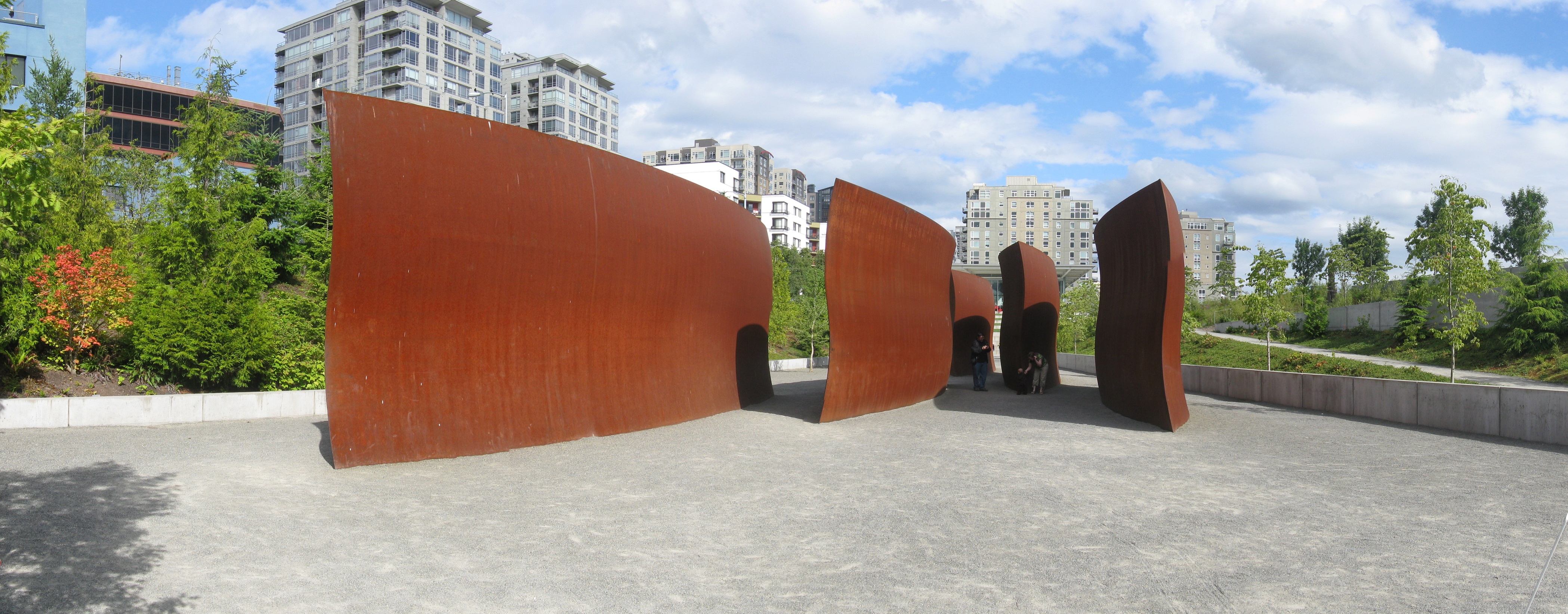
Hulls of ships? Fish in a stream? Downtown skyscrapers? I love how many different ways there are to look at this, and how you can go in and around it and keep getting different perspectives.
A quick jaunt across downtown to drop of the bike (after two days, thanks bike!) and I was back at the hotel to meet Sharon for a nice dinner at a swanky bar a few blocks away.
Tuesday July 13th
This would be Sharon’s only other day to get to see Seattle, having otherwise been busy in the conference, so the plan was jam packed and carefully choreographed with the transit buses (thanks again Google Maps for transit mode).
First up was the new Rem Koolhaas Central Library. Probably my biggest regret of this trip is that we didn’t spend more time here. It turns out that we approached from the “wrong” side, into a somewhat subterranean foyer very much like the Atlanta library, meaning not so great. We looked around for a minute and headed back out to proceed with our day. Only after we got home to Atlanta did I look at the introductory pamphlet that Sharon had grabbed, and that building is astonishing! Duh.
Moving on … we walked down to the waterfront to catch a streetcar ride along it. After some drama we did finally catch that ride and ended up at the Sculpture Garden.
 From there we stopped by the CoCA Ballard gallery (freakishly small, literally the size of a closet) on our way to catching a bus out through the Magnolia neighborhood, and took a cool woodsy trail down to the Chittendon Locks, aka the Ballard Locks. Fish ladder. Good stuff. And this time took a closer look at the garden, with impossibly huge flowers.
From there we stopped by the CoCA Ballard gallery (freakishly small, literally the size of a closet) on our way to catching a bus out through the Magnolia neighborhood, and took a cool woodsy trail down to the Chittendon Locks, aka the Ballard Locks. Fish ladder. Good stuff. And this time took a closer look at the garden, with impossibly huge flowers.
We walked about a mile out to the main CoCA gallery, which overlooks Shilsole Bay. Hear this: do not spend a shred of effort trying to get to CoCA. What a hilarious disappointment. Housed in some sort of private “beach club” event hall, it’s basically a hallway with baaaaad student art. The exhibit they had up was, no joke, literally a direct application of the bad-photo-plus-helvetica art meme. Spend your efforts elsewhere.
We high-tailed it out of there and over to Fremont. Which was kind of quiet, and the fact that Deluxe Junk was closed was a bummer (open Friday though Monday? Whatever.) Got an obligatory view of the grotesque Fremont Troll and then trekked down the hill to Gasworks Park (again, this time both of us). And back to the hotel by bus, exhausted.
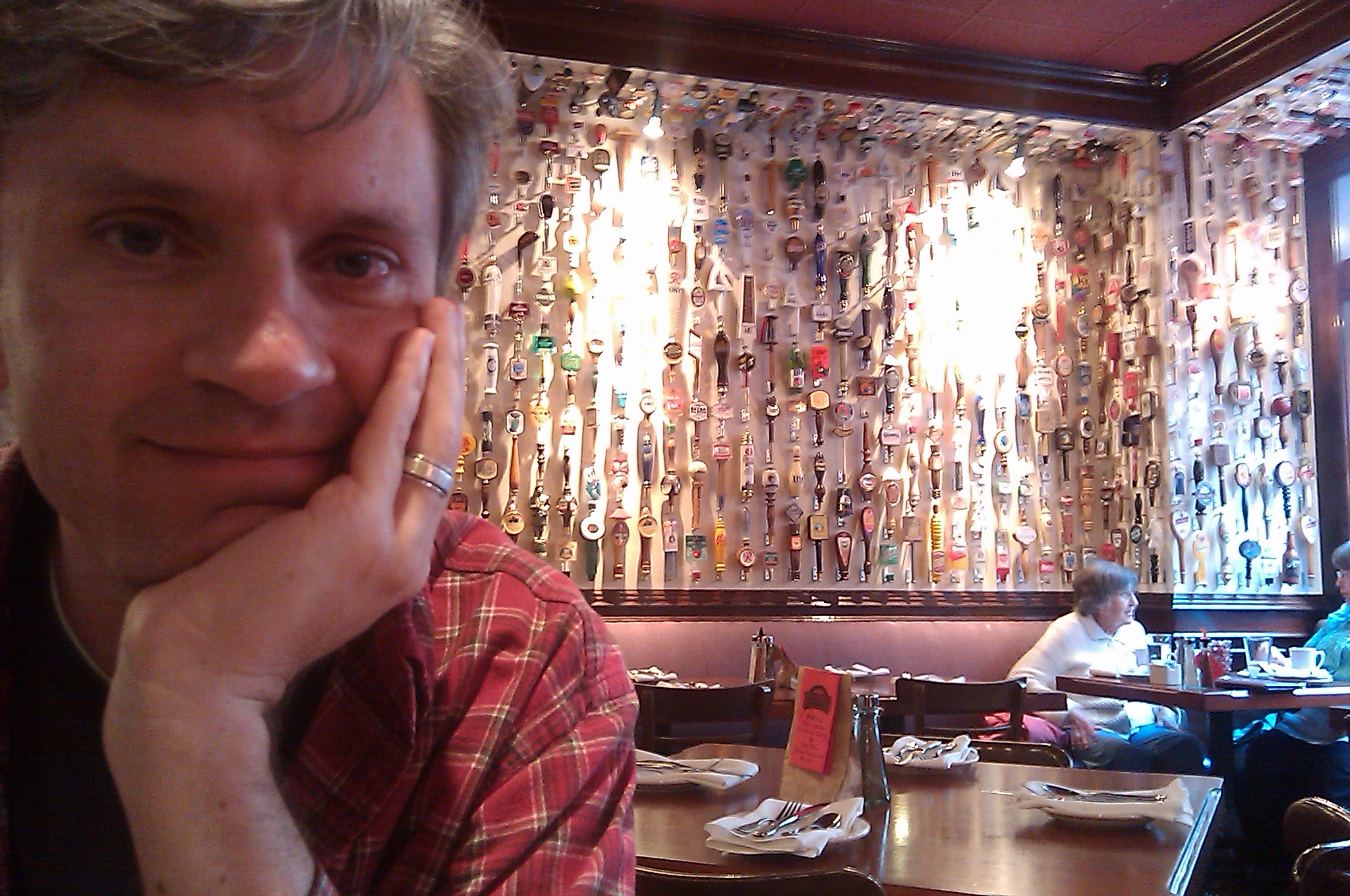 Final stop: the touristy restaurant a block from the hotel. Walls covered in beer tap handles, attracting a mix of tourist dullards and drunk rednecks. We were served an assortment of meat in impossibly huge portions. And got the hard upsell from the wait staff.
Final stop: the touristy restaurant a block from the hotel. Walls covered in beer tap handles, attracting a mix of tourist dullards and drunk rednecks. We were served an assortment of meat in impossibly huge portions. And got the hard upsell from the wait staff.
Wednesday July 14th
Flew back home. To have Mount Rainier, Mount St. Helens and Mount Adams all out there in the distance is an amazing sight, massive conical volcano peaks poking sharply above the mountains around them. Even Mount Hood was visible, a hundred miles away in Oregon! It’s quite a shock to be flying over hundreds of miles of mountain ranges (the Rockies and Cascades) and suddenly see a mountain towering even higher.
 I took delivery of my Chevy Volt (one of the first in the country!) on December 22nd, and it’s been performing beautifully ever since. It really is amazing that GM pulled this off and one of these is sitting in my driveway. I’m doing demo drives for friends and coworkers nearly every day, spreading the word and dispelling myths.
I took delivery of my Chevy Volt (one of the first in the country!) on December 22nd, and it’s been performing beautifully ever since. It really is amazing that GM pulled this off and one of these is sitting in my driveway. I’m doing demo drives for friends and coworkers nearly every day, spreading the word and dispelling myths.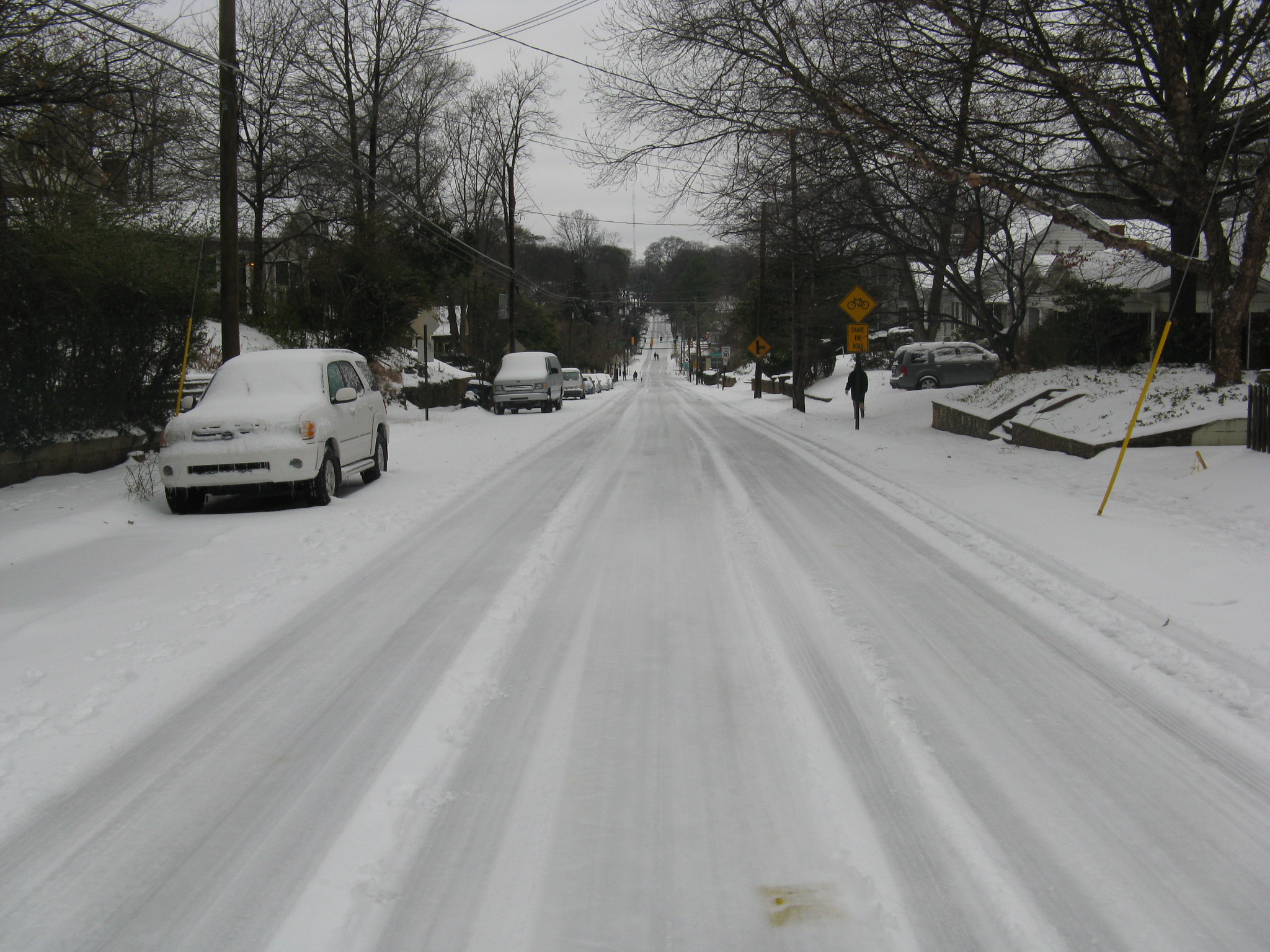 when I thought it was safe enough to drive but didn’t want to risk it with my brand new Volt. Otherwise the only time I’ve driven the Audi was on two days to take it to and from the repair shop, where I had a few things fixed to get it ready for sale.
when I thought it was safe enough to drive but didn’t want to risk it with my brand new Volt. Otherwise the only time I’ve driven the Audi was on two days to take it to and from the repair shop, where I had a few things fixed to get it ready for sale. Of course sound systems are of great interest to college students of all stripes (matched only by the subject of cars), so that was a very popular course. His
Of course sound systems are of great interest to college students of all stripes (matched only by the subject of cars), so that was a very popular course. His 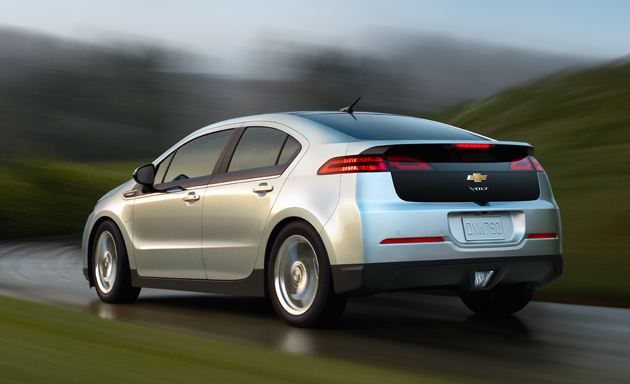 Two weeks ago, GM finally announced the sticker price of the Volt: $41,000. That’s a high number, even after the $7,500 federal tax credit, and it sent the fanboys into a tailspin of despair and vicious criticism of GM. There are lots of reasons why GM might have set that price point, which I won’t go into here. But what was really interesting was the second part of the announcement: the leasing terms. GM will lease the car for $350/month for 36 months, with $2500 down. Those are lease terms that you’d see for a much cheaper car, more like $20K-$25K, and show that GM is actually subsidizing and encouraging the lease. So that really got my attention, and within days I decided it was time to start contacting Chevy dealers.
Two weeks ago, GM finally announced the sticker price of the Volt: $41,000. That’s a high number, even after the $7,500 federal tax credit, and it sent the fanboys into a tailspin of despair and vicious criticism of GM. There are lots of reasons why GM might have set that price point, which I won’t go into here. But what was really interesting was the second part of the announcement: the leasing terms. GM will lease the car for $350/month for 36 months, with $2500 down. Those are lease terms that you’d see for a much cheaper car, more like $20K-$25K, and show that GM is actually subsidizing and encouraging the lease. So that really got my attention, and within days I decided it was time to start contacting Chevy dealers. I (Chris) continue to be a giddy little boy when it comes to flying. I always want a window seat, and I really do spend most of the flight, even a 5 hour flight like this one, with my face pressed to the window looking down in amazement. And also looking at my GPS receiver, which I received for Christmas from my family a few years ago specifically for this purpose — seeing what I was flying over.
I (Chris) continue to be a giddy little boy when it comes to flying. I always want a window seat, and I really do spend most of the flight, even a 5 hour flight like this one, with my face pressed to the window looking down in amazement. And also looking at my GPS receiver, which I received for Christmas from my family a few years ago specifically for this purpose — seeing what I was flying over. Arrived in SEA-TAC airport, took the shiny new
Arrived in SEA-TAC airport, took the shiny new  So we punted and took the monorail out to Seattle Center. The monorail, built in 1962 for the Worlds Fair (coughknoxvillecough), is perfectly functional but looking a bit dated, and really only goes from Tourist Point A (Westlake / downtown area) to Tourist Point B (Seattle Center). Seattle Center is most known for the Space Needle (more 1962 municipal construction) and the Experience Music Project, both of which we planned to studiously avoid. There was a indie craft fair (excuse me, “
So we punted and took the monorail out to Seattle Center. The monorail, built in 1962 for the Worlds Fair (coughknoxvillecough), is perfectly functional but looking a bit dated, and really only goes from Tourist Point A (Westlake / downtown area) to Tourist Point B (Seattle Center). Seattle Center is most known for the Space Needle (more 1962 municipal construction) and the Experience Music Project, both of which we planned to studiously avoid. There was a indie craft fair (excuse me, “ From there we backtracked a bit to where we’d spotted
From there we backtracked a bit to where we’d spotted  Escaped from there and on the way back to the transit station Sharon spotted a “variety store” advertising Asian wares. Inside we found a truly strange and wonderful place.
Escaped from there and on the way back to the transit station Sharon spotted a “variety store” advertising Asian wares. Inside we found a truly strange and wonderful place. 

 Finally reaching
Finally reaching 



 From there we stopped by the CoCA Ballard gallery (freakishly small, literally the size of a closet) on our way to catching a bus out through the Magnolia neighborhood, and took a cool woodsy trail down to the Chittendon Locks, aka the Ballard Locks. Fish ladder. Good stuff. And this time took a closer look at the garden, with impossibly huge flowers.
From there we stopped by the CoCA Ballard gallery (freakishly small, literally the size of a closet) on our way to catching a bus out through the Magnolia neighborhood, and took a cool woodsy trail down to the Chittendon Locks, aka the Ballard Locks. Fish ladder. Good stuff. And this time took a closer look at the garden, with impossibly huge flowers. Final stop: the touristy restaurant a block from the hotel. Walls covered in beer tap handles, attracting a mix of tourist dullards and drunk rednecks. We were served an assortment of meat in impossibly huge portions. And got the hard upsell from the wait staff.
Final stop: the touristy restaurant a block from the hotel. Walls covered in beer tap handles, attracting a mix of tourist dullards and drunk rednecks. We were served an assortment of meat in impossibly huge portions. And got the hard upsell from the wait staff. Launch wasn’t going to be until Friday, but I’ve learned from previous trips that I need to get there and onsite at KSC early on the day before a launch because they will have some unique things planned for the media, like a tour of some facility that is otherwise off limits to the public. But you have to get there first thing in the morning and check out the signup sheets. Which I did, and found that they were offering a tour of the
Launch wasn’t going to be until Friday, but I’ve learned from previous trips that I need to get there and onsite at KSC early on the day before a launch because they will have some unique things planned for the media, like a tour of some facility that is otherwise off limits to the public. But you have to get there first thing in the morning and check out the signup sheets. Which I did, and found that they were offering a tour of the  kind of a letdown (the ultimate would be the VAB or an OPF) but I’ll take it. So I signed up and then had a couple hours to kill before it started.
kind of a letdown (the ultimate would be the VAB or an OPF) but I’ll take it. So I signed up and then had a couple hours to kill before it started.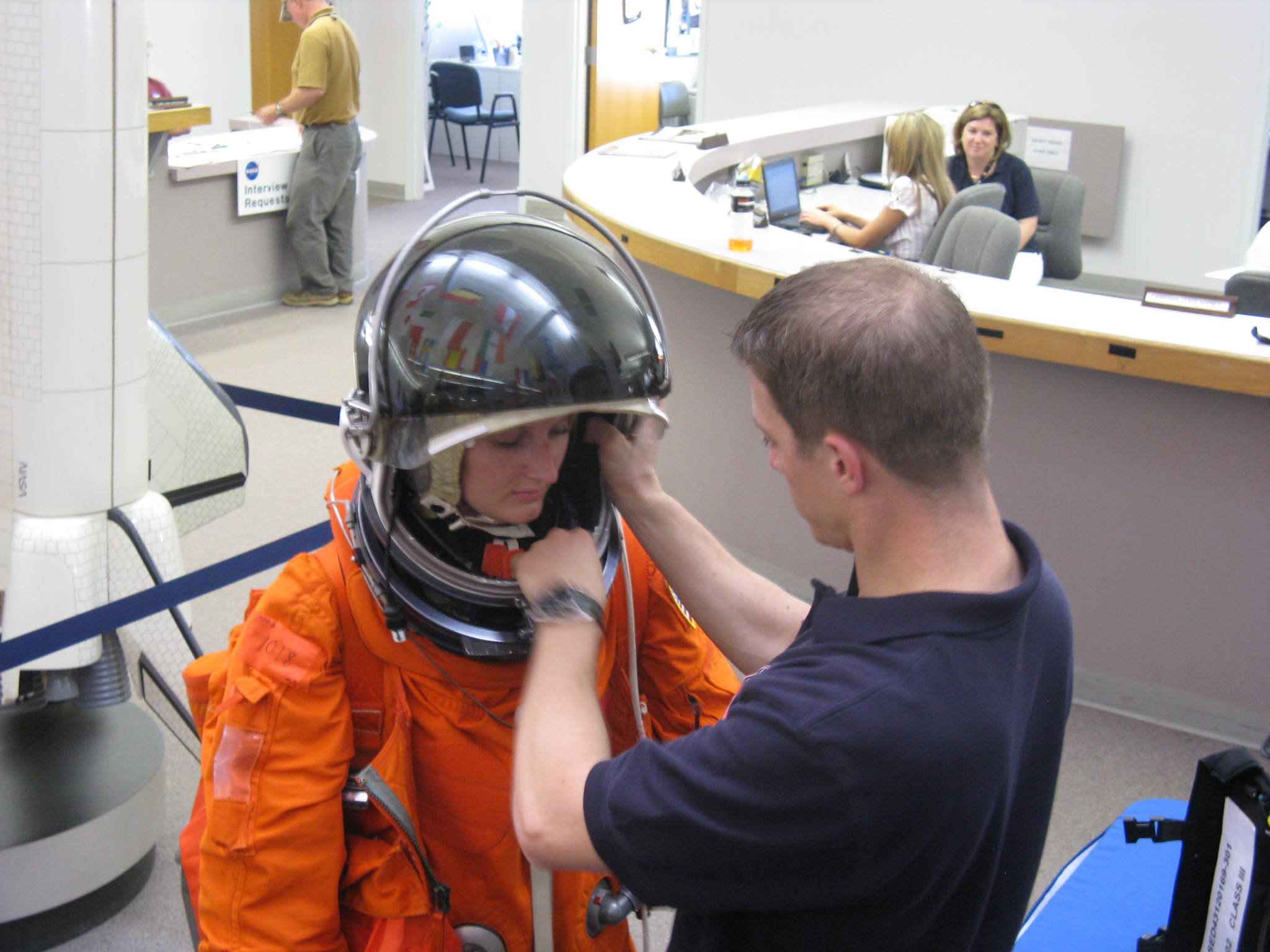 The briefing wrapped up and I killed some more time, and then got ready to go on the SLSL tour. Bastards left early. No tour. Bah!
The briefing wrapped up and I killed some more time, and then got ready to go on the SLSL tour. Bastards left early. No tour. Bah!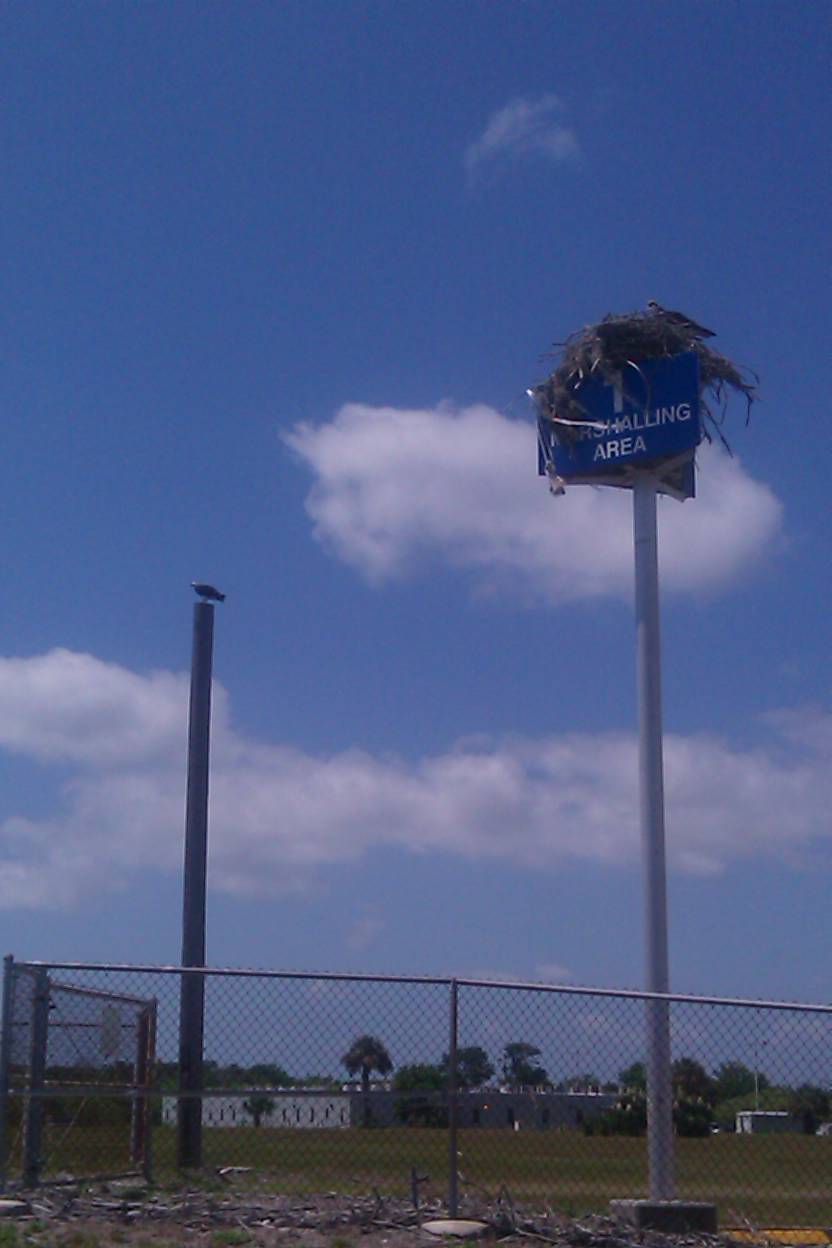 and up front are various NASA representatives available to answer any question, and all around are various TVs showing the NASA TV feeds. So in a modest area up front, they had a space suit expert who had brought in a suit and was dressing up some poor young lady from public affairs staff in it and explaining the parts as he went along. This wasn’t the big white suit they use for spacewalks, rather the orange “launch and entry” suit that the astronauts wear when inside the space shuttle during the hazardous phases at the very beginning and end of each mission. Pressurized air, coolant loops, helmet with visors, and even an emergency life raft and oxygen.
and up front are various NASA representatives available to answer any question, and all around are various TVs showing the NASA TV feeds. So in a modest area up front, they had a space suit expert who had brought in a suit and was dressing up some poor young lady from public affairs staff in it and explaining the parts as he went along. This wasn’t the big white suit they use for spacewalks, rather the orange “launch and entry” suit that the astronauts wear when inside the space shuttle during the hazardous phases at the very beginning and end of each mission. Pressurized air, coolant loops, helmet with visors, and even an emergency life raft and oxygen.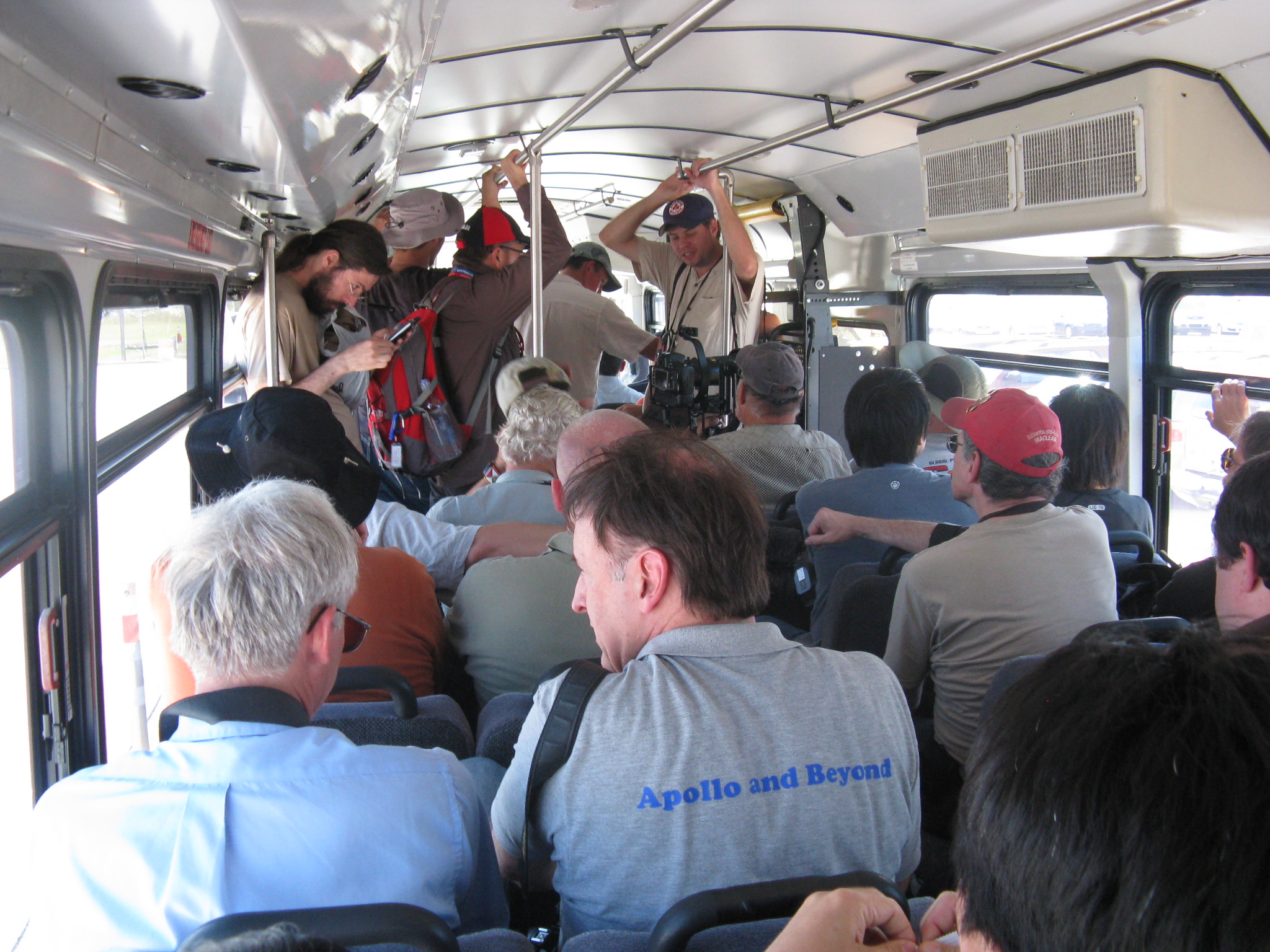 After that, I grabbed a quick bite to eat at the cafeteria (the same one the workers use, another thrill) and then had a couple hours to kill until the next event. So I did a test setup of my telescope in the parking lot. I’d brought a telescope with me in March 2009, but this time I was bringing the fancier new one. I hadn’t actually used it in a couple months, and just threw it in the car for the drive down, so I needed to give it a full test before things got busy on launch day.
After that, I grabbed a quick bite to eat at the cafeteria (the same one the workers use, another thrill) and then had a couple hours to kill until the next event. So I did a test setup of my telescope in the parking lot. I’d brought a telescope with me in March 2009, but this time I was bringing the fancier new one. I hadn’t actually used it in a couple months, and just threw it in the car for the drive down, so I needed to give it a full test before things got busy on launch day.  I spent two hours swing it around, looking at the launch pad, osprey nests, airliners high overhead, vultures circling over the VAB, etc. It all looked like it was working and I packed it back up into the car. I had my head down looking in the eyepiece most of the time and laterfound that I hadn’t put sunscreen on my neck and now had a wicked sunburned “red neck”.
I spent two hours swing it around, looking at the launch pad, osprey nests, airliners high overhead, vultures circling over the VAB, etc. It all looked like it was working and I packed it back up into the car. I had my head down looking in the eyepiece most of the time and laterfound that I hadn’t put sunscreen on my neck and now had a wicked sunburned “red neck”.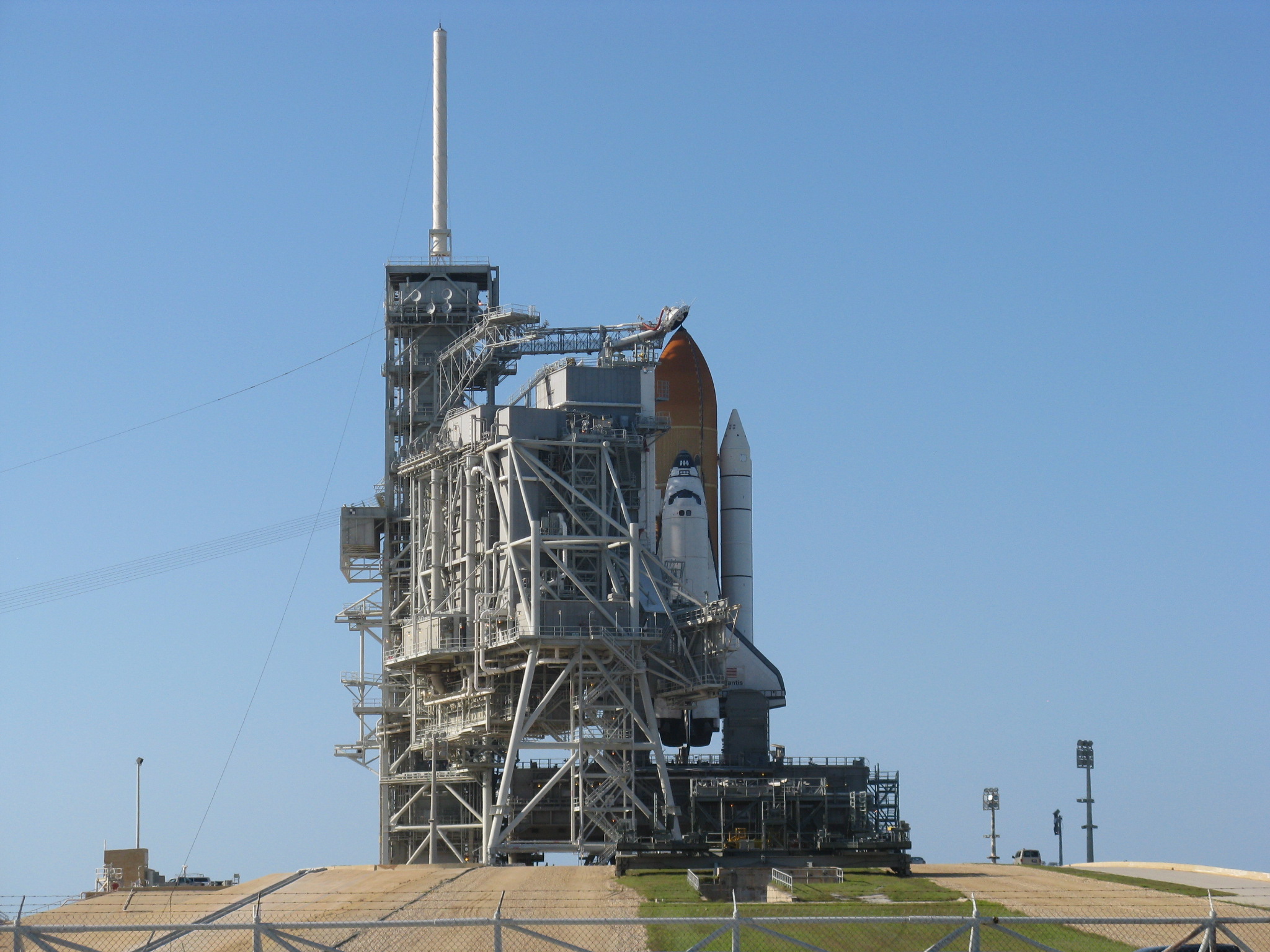 a trip out to the launch pad to see
a trip out to the launch pad to see 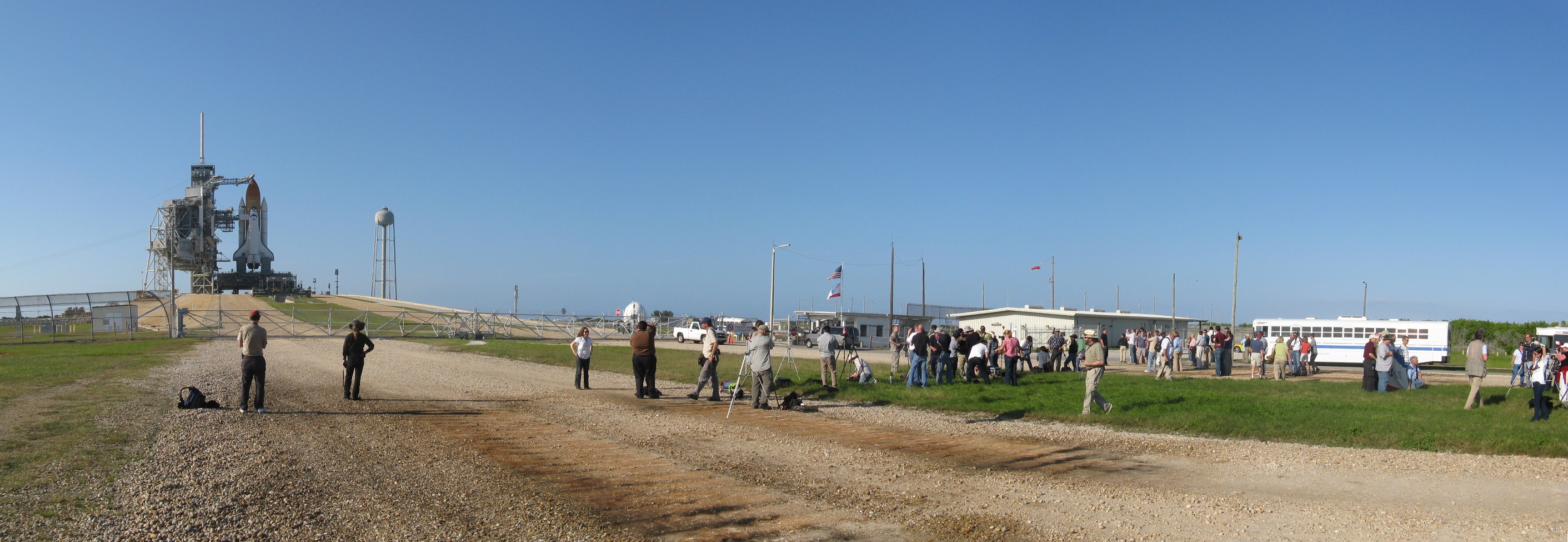
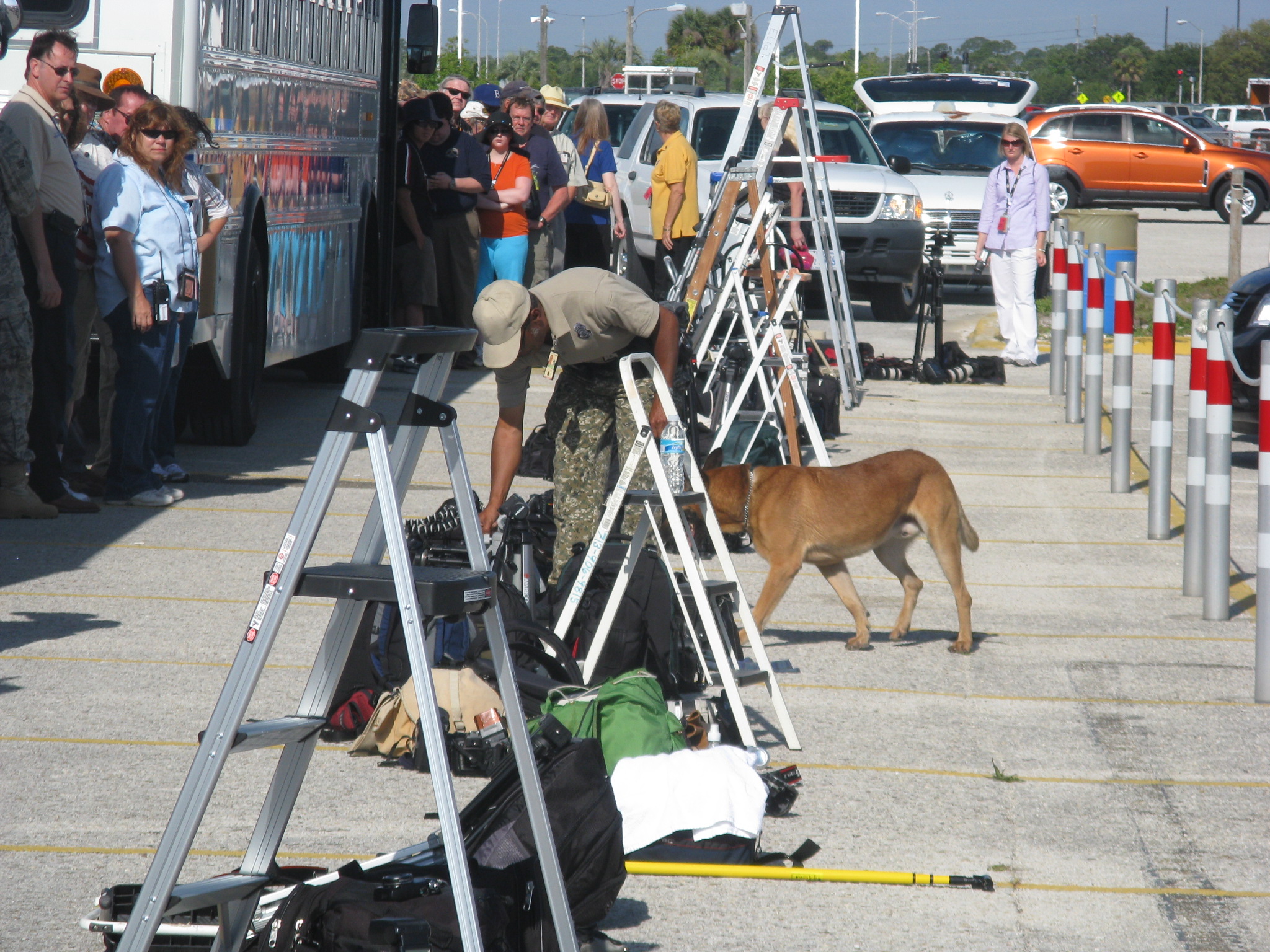 Got to KSC right on time and got in line for the busses. These were going to take us over to the
Got to KSC right on time and got in line for the busses. These were going to take us over to the 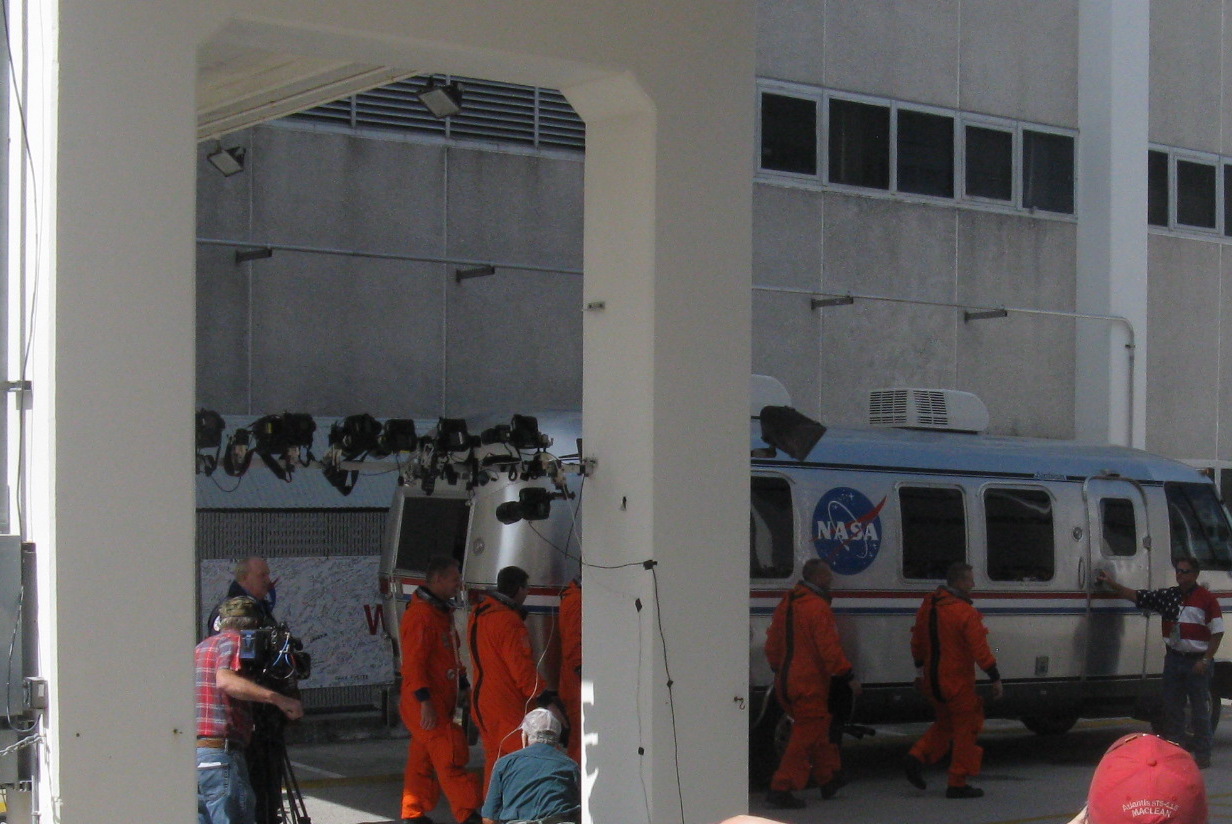 20 feet while they let the dogs go down the line sniffing for … weapons, I guess, although they’d probably not be too happy to find dope either.
20 feet while they let the dogs go down the line sniffing for … weapons, I guess, although they’d probably not be too happy to find dope either.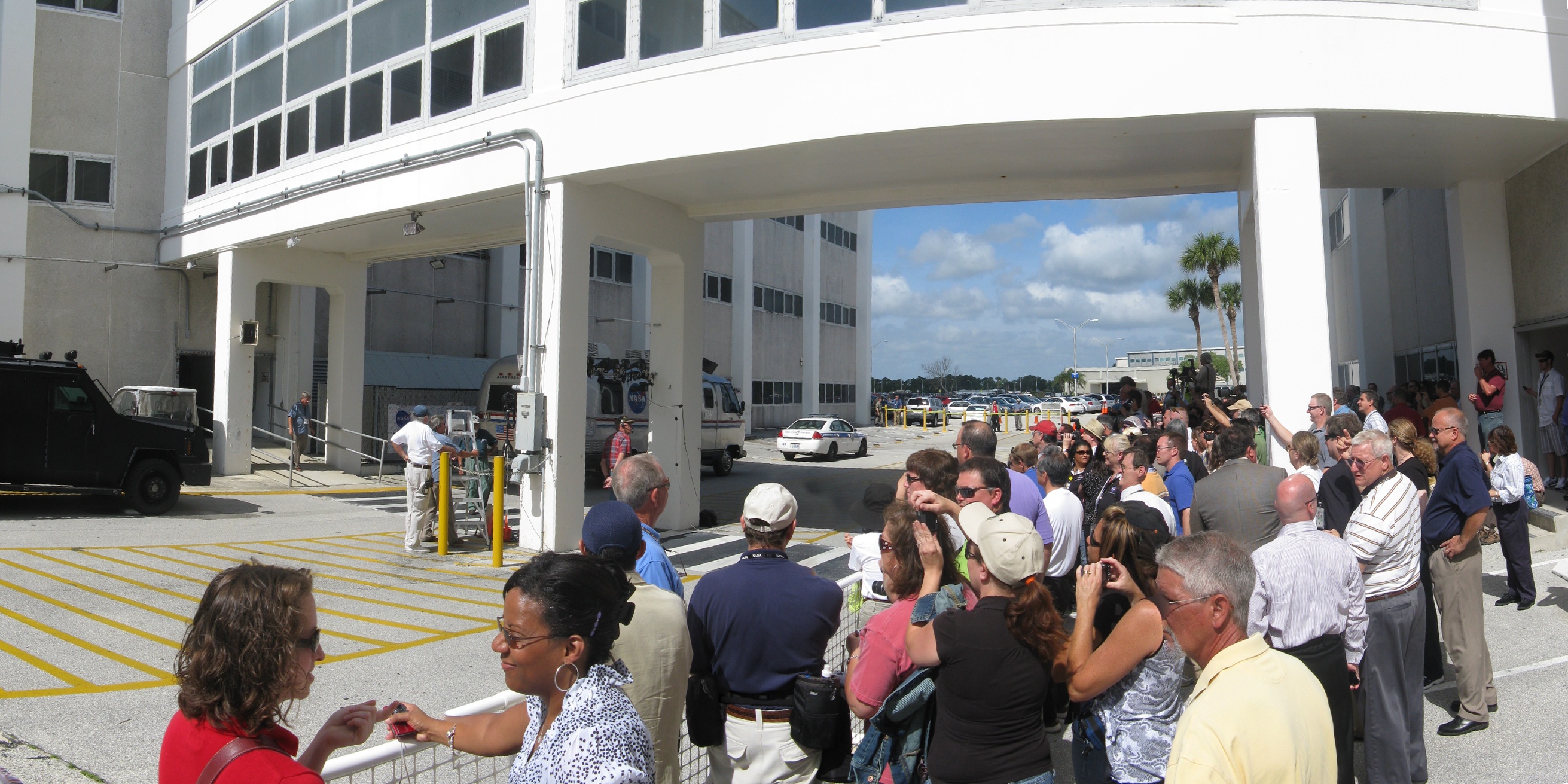
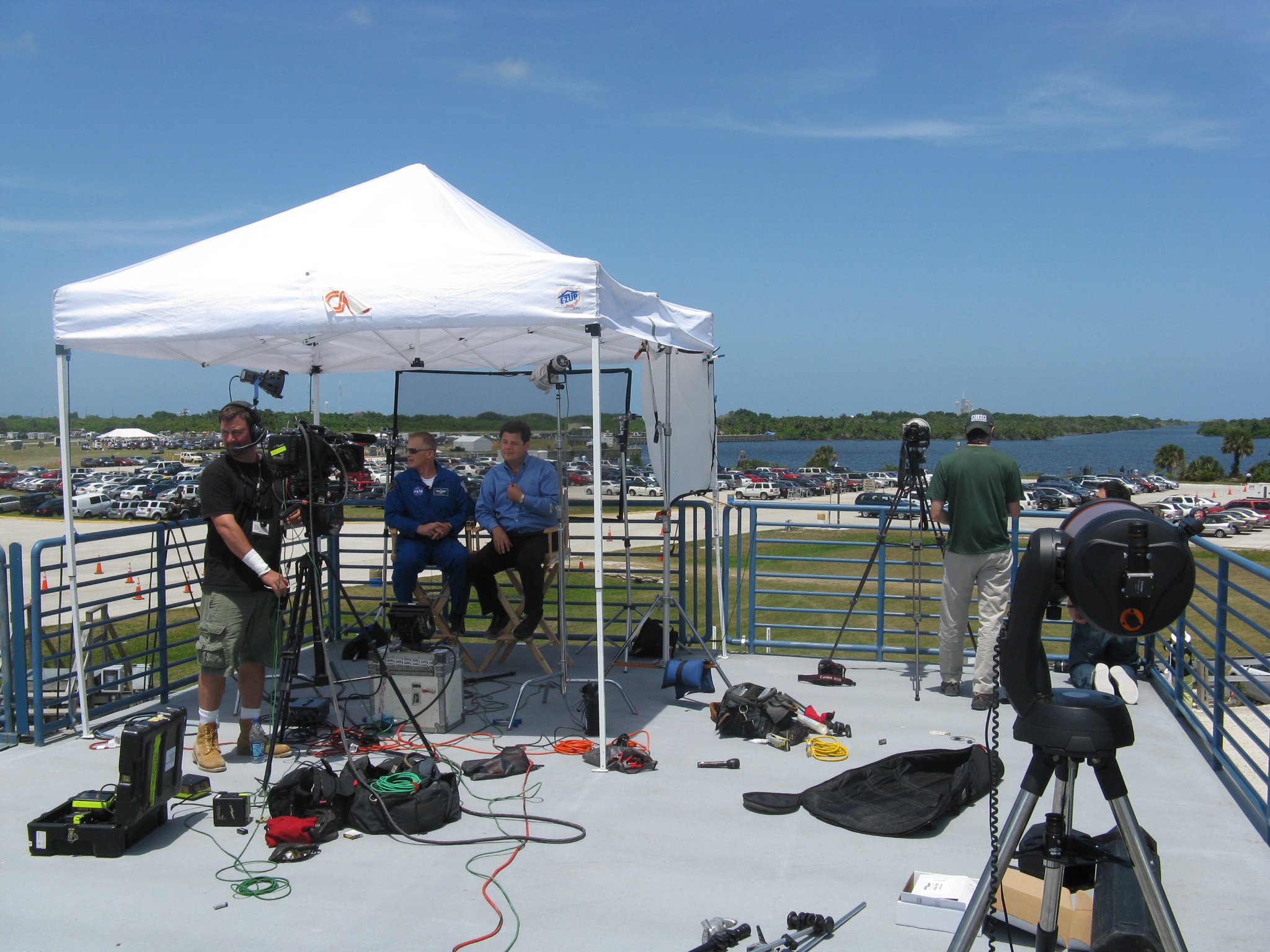 At one point my work colleagues interviewed NASA VIP Bobby Braun, and then just prior to launch astronaut Dave Wolf showed up to do on-air commentary with our reporter.
At one point my work colleagues interviewed NASA VIP Bobby Braun, and then just prior to launch astronaut Dave Wolf showed up to do on-air commentary with our reporter.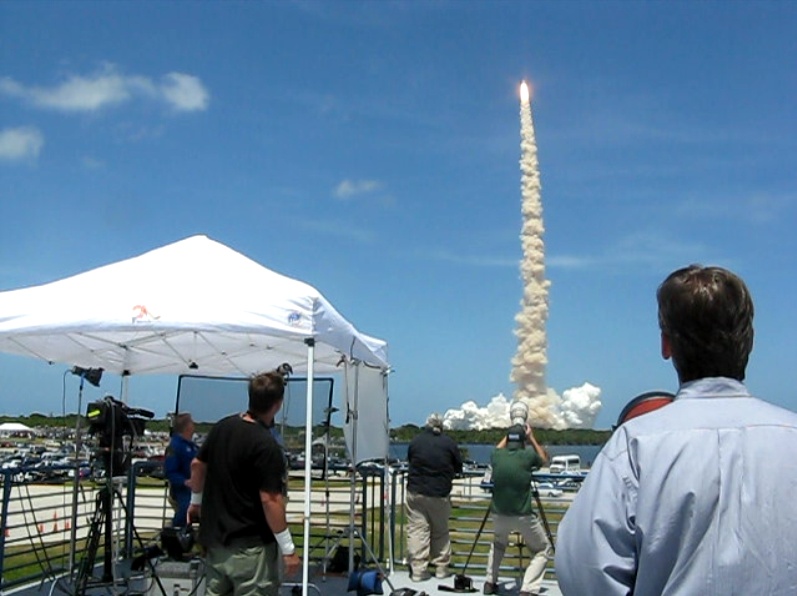 I’d brought my telescope in an attempt to track it on the way up. Tracking an object manually with a telescope (even a nice motorized model like the one I bought last year) is terribly difficult, because once you lose the object it’s very hard to get it back in view. Use of a finders scope (typically mounted on the side of the main telescope) is absolutely critical. I have one, that projects a virtual dot on the sky using an LED and a special lens, however I had made the unfortunate mistake of leaving the thing switched on. So at the moment of truth, 2:20pm, when I went to use it to track the shuttle racing up through the sky, the battery in the finder scope was dead. Damn it. I tried for a few seconds to catch it with the telescope and then gave up and just watched the launch with naked eyes.
I’d brought my telescope in an attempt to track it on the way up. Tracking an object manually with a telescope (even a nice motorized model like the one I bought last year) is terribly difficult, because once you lose the object it’s very hard to get it back in view. Use of a finders scope (typically mounted on the side of the main telescope) is absolutely critical. I have one, that projects a virtual dot on the sky using an LED and a special lens, however I had made the unfortunate mistake of leaving the thing switched on. So at the moment of truth, 2:20pm, when I went to use it to track the shuttle racing up through the sky, the battery in the finder scope was dead. Damn it. I tried for a few seconds to catch it with the telescope and then gave up and just watched the launch with naked eyes. Spun the car around and headed back in and got into the briefing room just in time to catch the briefing 🙂
Spun the car around and headed back in and got into the briefing room just in time to catch the briefing 🙂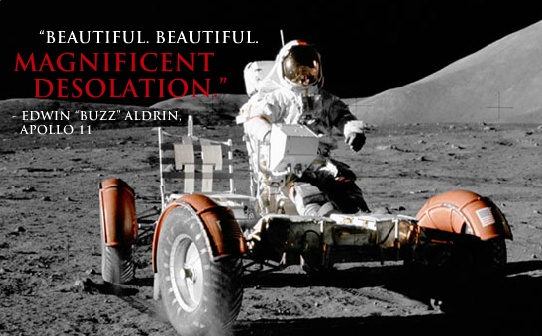 The Hubble movie I’d seen already (via long drive down to Columbus!) but wanted to see again just to catch more detail; it’s actually not that great of a production in my opinion, but I’ve been spoiled by watching the May 2009 STS-125 mission progress live at work and also the daily highlights in HD. But the other movie, Magnificent Desolation, is fantastic! (tagline: “Only 12 men have walked on the moon. You’re next.”) The general idea is to reintroduce young audiences to what exactly Apollo was, and so what they did was incorporate actual lunar surface footage with really stunning simulations of the lunar surface. In IMAX it is truly breathtaking. Go see this if you can!
The Hubble movie I’d seen already (via long drive down to Columbus!) but wanted to see again just to catch more detail; it’s actually not that great of a production in my opinion, but I’ve been spoiled by watching the May 2009 STS-125 mission progress live at work and also the daily highlights in HD. But the other movie, Magnificent Desolation, is fantastic! (tagline: “Only 12 men have walked on the moon. You’re next.”) The general idea is to reintroduce young audiences to what exactly Apollo was, and so what they did was incorporate actual lunar surface footage with really stunning simulations of the lunar surface. In IMAX it is truly breathtaking. Go see this if you can!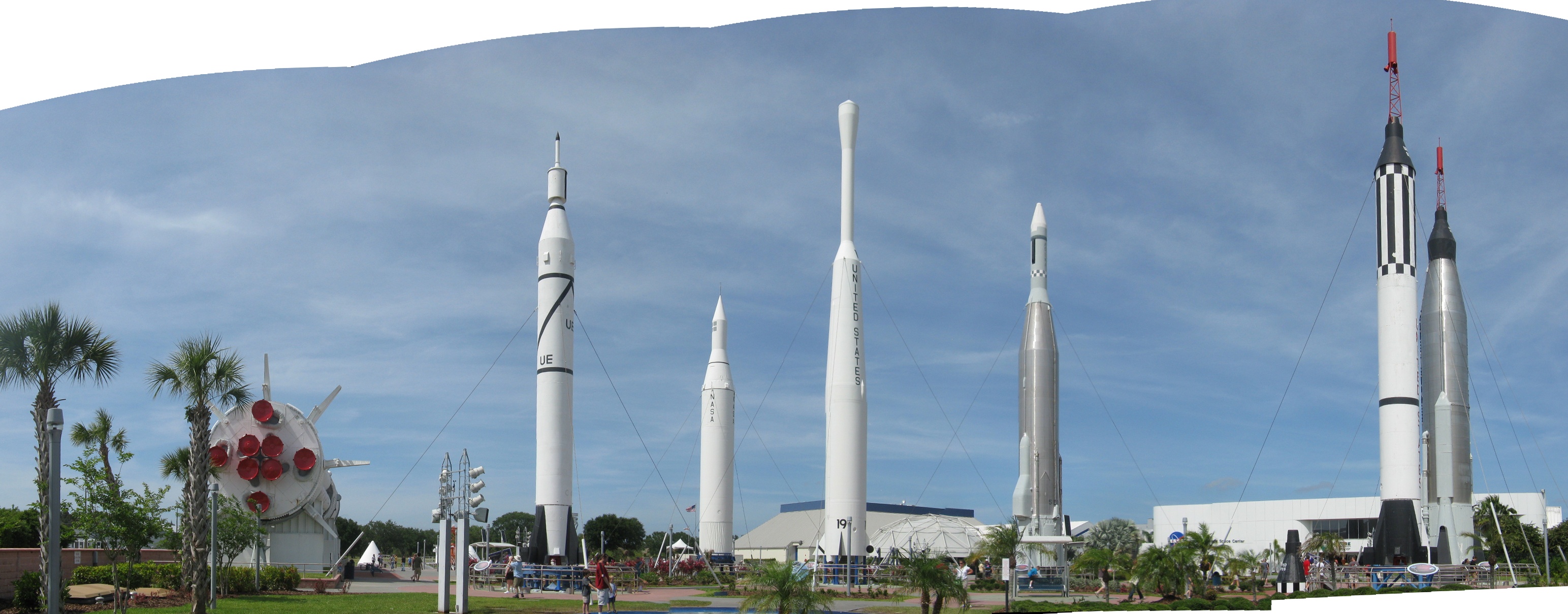
 There are cruise ships heading in and out of Port Canaveral all day long, and an unbelievable number of people all hanging out on the jetty and the beach nearby, apparently just enjoying the sun. It was actually crowded (and noisy) to the point of being claustrophobic, probably because it’s a free beach with easy access. Avoid Jetty Park.
There are cruise ships heading in and out of Port Canaveral all day long, and an unbelievable number of people all hanging out on the jetty and the beach nearby, apparently just enjoying the sun. It was actually crowded (and noisy) to the point of being claustrophobic, probably because it’s a free beach with easy access. Avoid Jetty Park.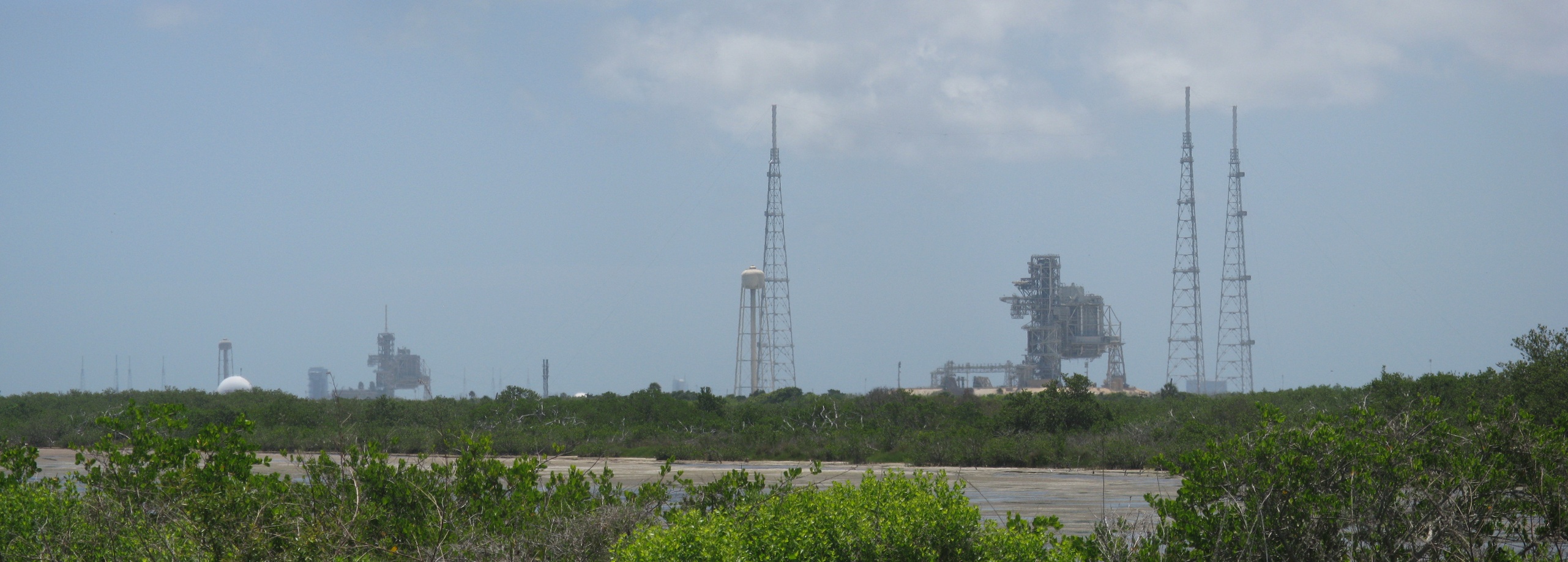
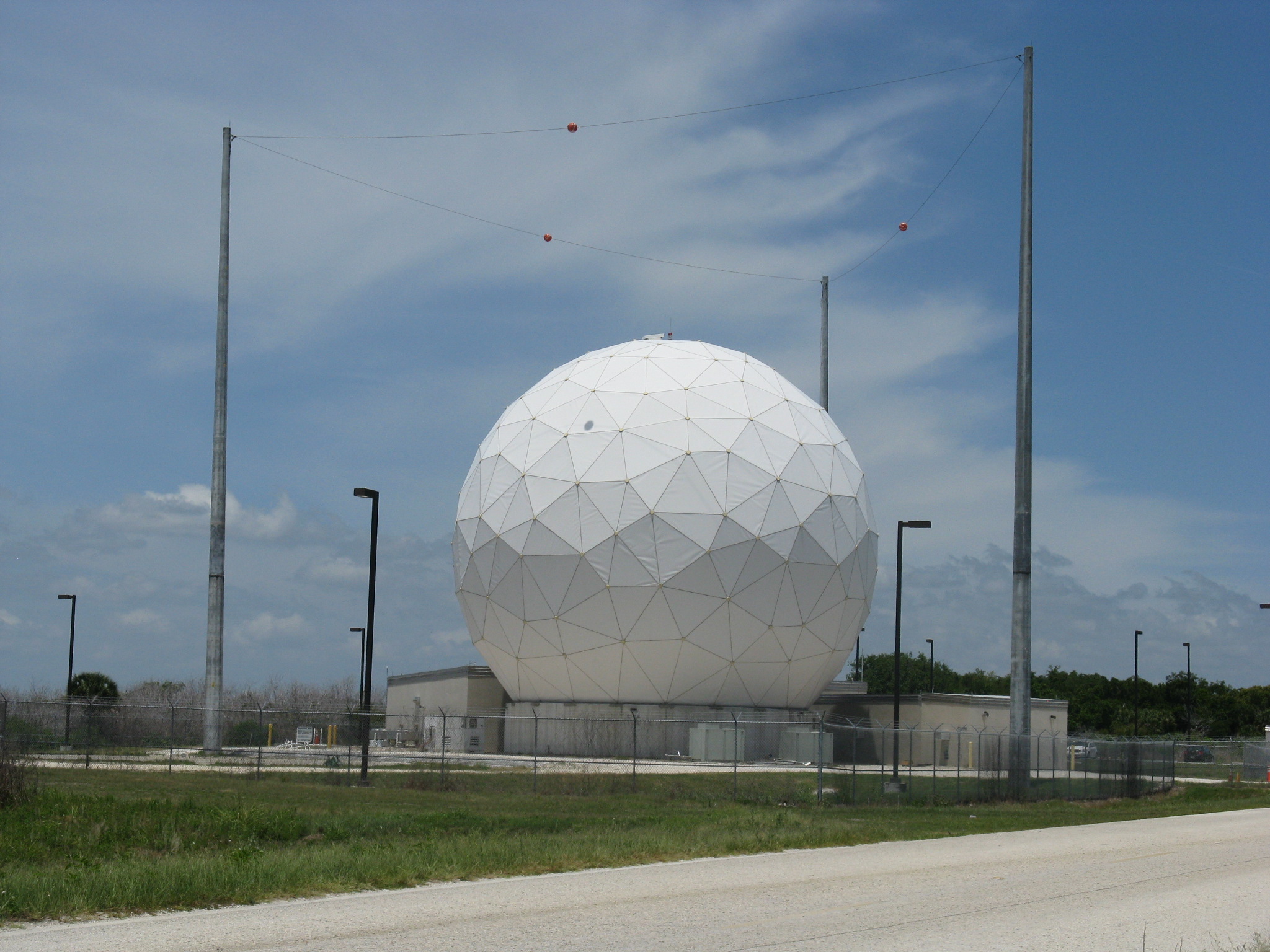 Here’s an excellent
Here’s an excellent